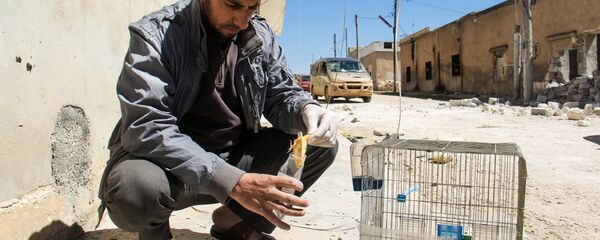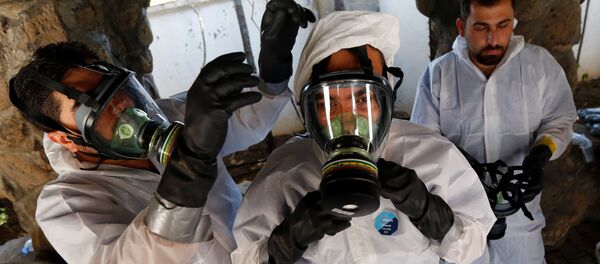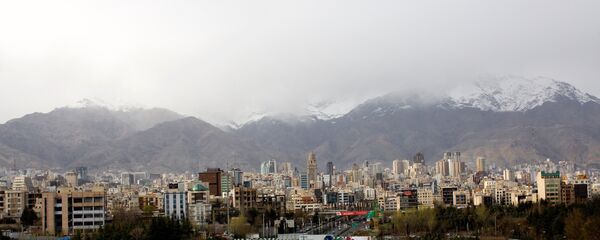MOSCOW (Sputnik) – The Organization for the Prohibition of Chemical Weapons (OPCW) and the United Nations used fabricated evidence in their Joint Investigative Mechanism (JIM) probe into April's chemical attack in the Syrian town of Khan Sheikhoun, threatening the reputation of international organizations, Professor Emeritus of Science, Technology, and National Security Policy at Massachusetts Institute of Technology Theodore A. Postol told Sputnik.
Last week, the JIM presented to the UN Security Council (UNSC) a confidential report on the attack, carried out in the Syrian opposition-held province of Idlib, reportedly killing over 80 people. Some Western media outlets, which had access to the report, quoted the document as saying that the government of Syria’s President Bashar Assad was held responsible for the chemical attack on April 4. The panel also reportedly blamed the Islamic State terror group (banned in Russia) for using sulfur mustard in an attack on Syria's Um Housh on September 16, 2016.
The report "relies on findings" of the OPCW Fact-Finding Mission (FFM) in Syria that was published this June following the investigation into the incident. The mission revealed that the victims had been exposed to sarin, a toxic substance, or a sarin-like substance. The FFM did not send its staff directly to the site, but completed the probe by conducting interviews, and collecting evidence and samples, such as video footage of the incident and hair from a dead goat found at the scene. The FFM also specified that it was unable to "implement a complete chain of custody, by the team, for samples from source."
Postol shared with Sputnik the results of his own research proving that the UN-OPCW probe into the Khan Sheikhoun incident was flawed and biased.
Postol’s Research
In his analysis, the expert referred to the well-publicized video footage taken by Orient News in Khan Sheikhoun very shortly after the alleged April 4 nerve agent attack. The video showed a dead goat that allegedly suffocated in the attack next to the targeted area. Postol underlined that this evidence could not be used because the animal's corpse could have been planted.
"As an inspection of the four images and the labels on the images clearly and unambiguously show, the dead goat in the image was dragged to the location where the journalists claim it died," Postol said.
According to the expert, the corpse's location could be easily established by other images taken in the Orient News video and other videos. The goat was located roughly 100 meters (328 feet) southeast of a crater that was considered the source of the sarin release.
"Perhaps most incredible in the OPCW report is an appendix that reports evidence of sarin use from analysis of a hair from the dead goat. Nowhere in the OPCW report is there any indication that the goat may have died elsewhere, possibly from sarin poisoning in a room or barn, and was then dragged to the location as an exhibit," Postol pointed out.
"There are many images of this crater that indicate subsequent tampering with the pipe that is vertically standing near the edge of the crater. In later photographs that can be seen that the pipe was pulled out from its vertical position in place flat at the center of the crater. This was then followed by claims that the pipe was a vessel containing sarin that was released at the site. Our calculations speculated that the crater was formed by a standard 122 mm artillery rocket explosive warhead of the kind that is ubiquitously available for purchase around the world," Postol pointed out.
Postol’s research included forensic computational analysis performed by two of his colleagues — Professor Goong Chen and Dr. Chung Gu, at Texas A&M University — which "unambiguously explains how this crater was actually created."
"The spent rocket motor casing of the rocket is embedded at the forward edge of the crater (not at the center as some people have asserted) and it is slightly bent forward by the sudden torque that occurs when the warhead impacts the asphalt surface. If we assume that the rocket casing was fabricated into a pipe and welded, our calculations show exactly the kind of split along the axis of symmetry of the pipe. This suggests that the rocket motor was manufactured locally and probably filled with a propellant that was locally produced. One such propellant that is commonly used in the manufacturing of improvised rocket motors is potassium nitrate and sugar," the expert explained.
Postol suggested that the rocket motor had been manufactured locally, and the warhead, igniter and nozzle had been attached to each end of the improvised rocket.
The expert then went into detail about the blast site, and the positions the rocket was found in.
"The arrival azimuth is easily identified because the rocket is embedded at the forward edge of the crater and the bent spent rocket casing also points forward along the direction of arrival. The cracking of the asphalt surface surrounding the crater is due to hot gases propagating through the underlying ground and pushing the asphalt vertically," the expert explained.
It was because of the above-mentioned observations Postol was able to determine the type of explosive device used and why it was not possible to definitely conclude that this warhead carried the alleged sarin toxin.
"It is therefore unambiguous that the crater was created by a standard 122 mm explosive warhead of the type that can be purchased anywhere in the world. There is absolutely no evidence of any sarin containing vessel. The split pipe that has been inaccurately identified as evidence of the container filled with sarin is simply the casing of the rocket motor that propelled the purchased warhead to the location of the explosion," the expert noted.
UN Reputation Threatened
"The information I am providing contains compelling and unambiguous evidence that the UN OPCW investigation of this matter was deeply flawed and biased. The fact that the UN OPCW did not have investigators under their direct control at the scene of the alleged nerve agent attack at Khan Sheikhoun on April 4, 2017 is no excuse for them making claims that are demonstrably false," Postol said.
Postol pointed to the fact that in their analyses, both the UN commission and the OPCW used publicly available information obtained from videos that "clearly showed attempts by local organizations to manipulate information."
"The fact that the OPCW has made no effort to verify the accuracy of this information indicates either extreme incompetence, or much more likely, extreme bias on the part of OPCW leadership. Of even greater concern is that the UN leadership is not exercising its fiduciary responsibilities to member countries by assuring that the OPCW is free of bias and incompetence," the expert continued.
By failing to properly investigate incidents like the supposed Khan Sheikhoun chemical weapons attack, the United Nations and the OPCW are most likely enabling various groups with military and political agendas to use nerve agents and then point a finger at their enemies, Postol suggested.
"Continuing failure to properly review the veracity of the OPCW claims will ultimately have serious negative consequences for the reputation of the UN. This will, in turn, have serious negative consequences for the role of the UN as a credible source of analysis with regard to other dismaying and potentially escalatory events that will certainly occur in the future," the expert emphasized.
Postol noted Russia's "well-justified" criticisms of the handling of the JIM by the UN leadership.
The expert called on Russia to introduce a proposal within the UNSC for his investigation results to be reviewed by the organization's authorities.
"Our interest is to help the UN reach a technically sound conclusion about the evidence that is available that indicates that the crater at Khan Sheikhoun has been misidentified as the source of a sarin release," Postol explained.
Postol believes the data on flaws in the UN-sponsored report on the alleged use of sarin in Khan Sheikhoun provides strong ground for the Russian UN delegation to seek a review of the JIM report, because the misidentified source of the sarin attack, as outlined by Postol, casts doubts on whether the JIM report can accurately claim Assad as the responsible party.
Fabricated Casus Belli
After the incident in Khan Sheikhoun, the United States launched 59 Tomahawk cruise missiles at the Syrian military airfield in Ash Sha’irat in the province of Homs from which the chemical attack was allegedly carried out.
"My concern was that the United States attack against Syria would encourage these rebel groups to engage in false attacks, attack people with sarin and then blame it on the Assad government. So that’s what got me involved at looking at this," Postol explained.
Postol reiterated the lack of reliable evidence in the UN and OPCW materials, as all the information that the investigators used had been fabricated, misidentified and misinterpreted.
Also, the expert pointed out the lack of methodology, noting that the investigators’ findings were "filled with errors."
"They made no attempt at all to determine the veracity of the evidence, that their claims can reach that conclusion. There was a very substantial indication that I put in the report for you that indicated that the site where the alleged sarin release occurred could not have been [the place where] there was a sarin release … but those things were clearly staged, clearly fraudulent," Postol continued.
The UN chief's spokesman said on Thursday that he had trust in the professionalism and objectivity of the OPCW-UN joint mechanism.
Meanwhile, on Friday, Russian Deputy Foreign Minister Sergey Ryabkov told Sputnik the methodology of the OPCW-UN report on chemical weapon use in Syria was flawed with based no biased evidence. He continued by saying that after an in-depth analysis of the JIM report and presentation of conclusions, Russia would put forward specific measures and steps aimed at "improving dramatically this unacceptable position and put the investigation of crimes with chemical weapons use on a solid, reliable … basis."
The JIM revealed its report two days after Russia blocked a UNSC resolution extending its mandate in Syria, set to expire on November 16, for another year. The Russian Foreign Ministry has said that the decision on the prolongation of the UN-OPCW investigators’ mandate must not be made by the UNSC until the examination of the probe results.






